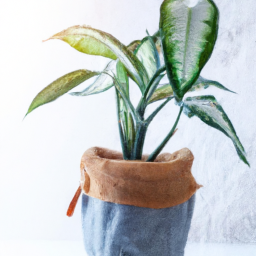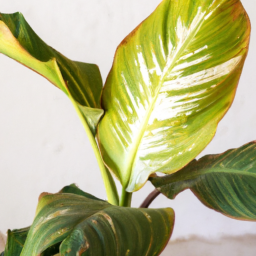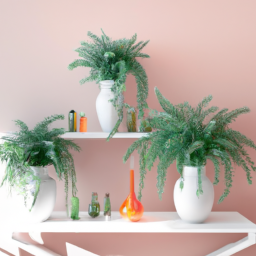
As the winter season approaches, many plant lovers may find themselves wondering how to care for their indoor plants during the colder months. Indoor plants in winter require special attention and care to ensure they thrive despite the harsh conditions outside. With the right knowledge and techniques, you can help your indoor plants survive and even flourish during the winter season. In this blog post, we will explore the best practices for caring for indoor plants in winter, including tips for adjusting watering schedules, providing adequate light, and protecting plants from drafts and dry air. So grab a cup of tea, cozy up, and let’s dive into the world of indoor plants in winter.
Benefits of Keeping Indoor Plants During Winter
As an expert on indoor plants, I can tell you that there are numerous benefits to keeping indoor plants during the winter months. Not only do they add a touch of greenery to your home, but they also have a positive impact on your physical and mental well-being. Here are some of the key benefits of keeping indoor plants during winter:
Improved Air Quality
Indoor plants are natural air purifiers, helping to remove toxins and pollutants from the air. During the winter months when windows are closed and indoor air can become stale, indoor plants play a crucial role in keeping the air in your home clean and fresh. Plants such as peace lilies, spider plants, and pothos are particularly effective at filtering out harmful chemicals and improving indoor air quality.
In addition to removing toxins from the air, indoor plants also release oxygen through the process of photosynthesis. This can help to boost your mood and energy levels, especially during the dark and dreary winter months. By keeping indoor plants in your home, you can create a healthier and more pleasant living environment for yourself and your family.
Furthermore, indoor plants can help to regulate humidity levels in your home, which can be particularly beneficial during the dry winter months. Plants release moisture through their leaves, helping to combat the dry air caused by indoor heating systems. This can prevent issues such as dry skin, sore throats, and respiratory problems, keeping you and your family comfortable and healthy throughout the winter.
Reduced Stress and Anxiety
Studies have shown that indoor plants can have a calming effect on the mind, helping to reduce stress and anxiety. The presence of plants in your home can create a sense of tranquility and connection to nature, which is especially important during the winter when outdoor activities may be limited. Simply caring for and nurturing your indoor plants can be a therapeutic and meditative practice, providing a much-needed respite from the hustle and bustle of daily life.
In addition, the green color of plants has been found to have a soothing effect on the eyes and mind, helping to promote relaxation and mental clarity. By surrounding yourself with indoor plants during the winter months, you can create a peaceful and rejuvenating sanctuary in your home, where you can escape from the stresses of the outside world and recharge your batteries.
Furthermore, the act of caring for indoor plants can provide a sense of purpose and accomplishment, boosting your mood and self-esteem. Watching your plants thrive and grow can be incredibly rewarding, giving you a sense of pride and satisfaction. This can be especially important during the winter when feelings of isolation and lethargy are common, helping to lift your spirits and improve your overall well-being.
Enhanced Home Decor
Indoor plants are not only beneficial for your health and well-being, but they also serve as stylish and versatile home decor elements. With a wide variety of plant species to choose from, you can easily find plants that complement your existing decor style and color scheme. Whether you prefer sleek and modern plants like succulents and air plants, or lush and tropical plants like ferns and palms, there is a plant for every taste and preference.
During the winter when outdoor gardens may be dormant, indoor plants can bring a touch of nature and vibrancy into your home. They can add texture, color, and visual interest to any room, creating a warm and inviting atmosphere. By strategically placing plants in key areas such as living rooms, bedrooms, and home offices, you can transform your space into a cozy and welcoming sanctuary that reflects your personality and style.
Furthermore, indoor plants can be used to create focal points and design accents in your home, drawing the eye and adding a sense of drama and elegance. Whether displayed in stylish planters, hanging baskets, or terrariums, indoor plants can elevate the aesthetic appeal of your home and make a statement. By incorporating indoor plants into your winter decor, you can create a visually stunning and harmonious living environment that you can enjoy throughout the season.

Best Indoor Plants for Winter Months
Choosing the Right Indoor Plants
During the winter months, it can be challenging to keep your indoor plants thriving. The key to success is choosing the right plants that are well-suited for the conditions inside your home during the colder months. Some plants are more resilient to low light and dry air, making them perfect choices for winter.
One great option is the snake plant, also known as mother-in-law’s tongue. This plant is extremely hardy and can tolerate low light and infrequent watering. Another excellent choice is the spider plant, which is known for its ability to purify the air and thrive in a variety of conditions. The peace lily is another popular option, as it can bloom indoors even in low light and is relatively easy to care for.
When selecting indoor plants for winter, be sure to consider the amount of light they will receive in your home. Plants that require high light may struggle in the darker months, so opt for varieties that can thrive in low to moderate light conditions. Additionally, consider the humidity levels in your home, as some plants may require more moisture in the air to thrive.
Caring for Indoor Plants in Winter
Once you have chosen the right indoor plants for winter, it’s important to provide them with the proper care to ensure they stay healthy and vibrant throughout the season. One key aspect of caring for indoor plants in winter is adjusting your watering schedule. With lower light levels and cooler temperatures, plants may require less frequent watering. Be sure to check the soil moisture before watering to avoid overwatering, which can lead to root rot.
In addition to adjusting your watering schedule, it’s important to monitor the humidity levels in your home. Indoor heating during the winter months can lead to dry air, which can be detrimental to many houseplants. To increase humidity around your plants, consider placing a humidifier nearby or grouping plants together to create a microclimate with higher moisture levels.
Another crucial aspect of caring for indoor plants in winter is ensuring they receive adequate light. While natural light may be limited during the darker months, you can supplement with artificial grow lights to provide your plants with the light they need to thrive. Positioning plants near windows or rotating them regularly can also help ensure they receive sufficient light for healthy growth.
Troubleshooting Common Issues
Even with the best care, indoor plants in winter may still encounter issues that can affect their health and appearance. One common problem is pests, such as spider mites and mealybugs, which can thrive in dry indoor conditions. To prevent infestations, regularly inspect your plants for signs of pests and treat them promptly with insecticidal soap or neem oil if necessary.
Another issue that indoor plants may face in winter is yellowing or dropping leaves. This can be caused by a variety of factors, including overwatering, underwatering, or insufficient light. To address this problem, carefully assess your plant’s care routine and make adjustments as needed. Trim any yellow or dead leaves to encourage new growth and improve the overall appearance of your plant.
In conclusion, selecting the right indoor plants for winter and providing them with proper care is essential for their health and vitality during the colder months. By choosing resilient plants, adjusting your care routine, and troubleshooting common issues, you can enjoy a thriving indoor garden throughout the winter season. Remember to monitor your plants regularly, make adjustments as needed, and enjoy the beauty and benefits of indoor plants in your home.

Tips for Caring for Indoor Plants in Winter
Understanding the Needs of Indoor Plants in Winter
As an expert in indoor plants, it’s important to understand the unique needs of your plants during the winter months. The lack of sunlight, dry indoor air, and fluctuating temperatures can all take a toll on your indoor plants. It’s essential to provide them with the right care to ensure they thrive during the colder months.
One of the most critical factors to consider is light. With shorter days and weaker sunlight in winter, your plants may not be getting the amount of light they need to photosynthesize effectively. Consider moving your plants closer to windows or investing in grow lights to supplement their light intake.
In addition to light, indoor plants also require proper humidity levels to thrive. The dry air that comes with indoor heating can be detrimental to many plants. To combat this, consider using a humidifier or placing a tray of water near your plants to increase the humidity levels in the air.
Watering Your Indoor Plants in Winter
Proper watering is crucial for the health of your indoor plants, especially during the winter months. While it’s essential not to overwater your plants, it’s also crucial not to let them dry out completely. The key is to strike a balance and adjust your watering schedule based on the specific needs of each plant.
During the winter, plants generally require less water due to the slower growth rate and lower light levels. Check the soil moisture regularly by sticking your finger into the soil. If it feels dry to the touch, it’s time to water. Be sure to use room temperature water to avoid shocking the roots of your plants.
It’s also essential to adjust your watering schedule based on the temperature of your home. If your home is particularly warm, your plants may require more frequent watering. Conversely, if your home is cooler, you may need to water less often.
Temperature and Air Circulation
Temperature plays a significant role in the health of your indoor plants during the winter months. Most indoor plants prefer temperatures between 65-75 degrees Fahrenheit during the day and slightly cooler temperatures at night. Avoid placing your plants near drafty windows or heat sources, as extreme temperature fluctuations can stress your plants.
Adequate air circulation is also crucial for the health of your indoor plants. Stagnant air can lead to an increase in pests and diseases. Consider using a fan to promote air circulation around your plants, but be mindful of not placing them directly in the path of the fan, as this can cause them to dry out more quickly.
By following these tips and providing your indoor plants with the care they need, you can ensure that they thrive throughout the winter months. Remember to monitor your plants regularly, adjust your care routine as needed, and enjoy the beauty and benefits of having indoor plants in your home.
In Summary
As winter approaches, many of us may be feeling the effects of the colder weather on our indoor plants. The lack of sunlight and dry indoor air can make it challenging to keep our green friends thriving during the winter months. However, with a little extra care and attention, we can help our indoor plants survive and even thrive through the winter season.
One way to help your indoor plants during the winter is to move them to a spot where they can get as much natural light as possible. South-facing windows are ideal for providing the most sunlight, but if that’s not an option, consider investing in a grow light to supplement their light intake. Additionally, be mindful of the humidity levels in your home, as dry air can be detrimental to many indoor plants. Consider using a humidifier or placing a tray of water near your plants to help increase the moisture in the air. With a little extra TLC, your indoor plants can make it through the winter and come out even stronger on the other side.
Your Questions Answered. Comprehensive FAQ:
Q1: Can indoor plants survive in winter?
A1: Yes, indoor plants can survive in winter as long as they are given proper care and attention. It’s important to adjust watering and lighting levels to accommodate the lower temperatures and reduced sunlight during the winter months.
Q2: How often should I water my indoor plants in winter?
A2: In winter, indoor plants generally require less frequent watering due to the lower levels of evaporation. It’s important to let the soil dry out slightly between waterings to prevent root rot. Check the soil moisture level before watering to ensure you’re not overwatering.
Q3: Do indoor plants need special care in winter?
A3: Indoor plants may require some special care in winter to thrive. Make sure to place them in well-lit areas to compensate for the reduced sunlight, and consider using a humidifier to combat dry indoor air. Avoid placing plants near drafty windows or heaters that can cause temperature fluctuations.
Q4: How can I protect my indoor plants from cold drafts in winter?
A4: To protect your indoor plants from cold drafts in winter, make sure to keep them away from drafty windows, doors, and vents. Consider placing a barrier, such as a curtain or plant stand, between your plants and the cold drafts. You can also use a humidifier to maintain a consistent temperature and humidity level around your plants.
Q5: Should I fertilize my indoor plants in winter?
A5: Indoor plants generally require less fertilizer in winter due to their slower growth rate. It’s best to avoid fertilizing during the dormant winter months, as this can lead to nutrient buildup in the soil. Resume fertilizing in spring when your plants start showing signs of new growth.
Dr. Olivia Green is a botanist with over two decades of experience in indoor plant cultivation. She holds a Ph.D. in Plant Biology and has dedicated her career to researching plant behavior in controlled environments. Dr. Green is passionate about helping plant enthusiasts master the art of indoor gardening through her extensive knowledge and practical insights.


